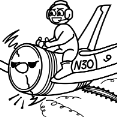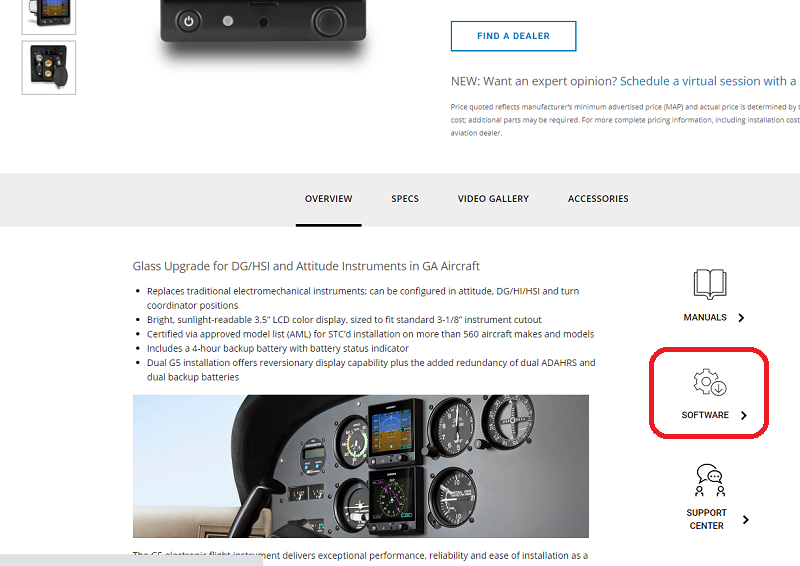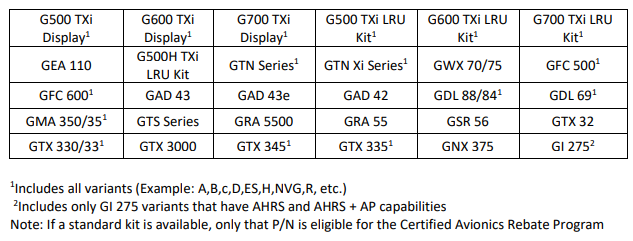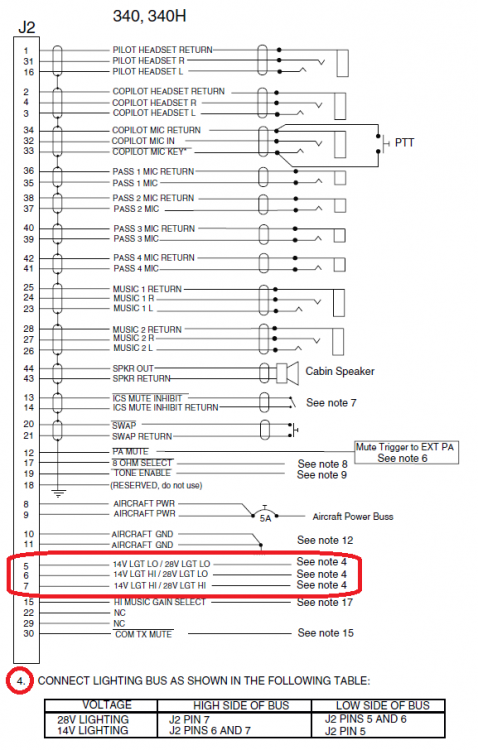-
Posts
77 -
Joined
-
Last visited
-
Days Won
1
Content Type
Profiles
Forums
Blogs
Gallery
Downloads
Events
Store
Everything posted by Minivation
-
I've recently done a few trips around the country in the mid-teens. I don't have a dedicated pulse oximeter, but my Galaxy S7 has one built-in. It might not be as convenient or accurate as dedicated ones, but it's good to know I'm at least carrying something around with me all the time.
-
Retreads and retractables generally don't mix well. Normally I'd recommend new Michelin or Goodyear tires, but the M20J I fly has been doing well with Condor tires (IIRC they are retreaded Michelin tires) for both the mains and the nose. Somebody please correct me if I'm wrong about the Condors being retread Michelins.
-
I think this list is good to go. I did have to double-check if the G5 is allowed to be used as a backup to the G500TXi, and yes, it is authorized. I haven't flown the G500TXi as a pilot, but I have done installation and maintenance work on them as an avionics tech. They are incredibly powerful devices and I am confident they will serve you well. Just make sure you spend the time to get used to the interface because they can get overwhelming!
-
Before hopping in the plane, I usually download a few Spotify-curated playlists enough to last me the flight. A typical flight for me lasts anywhere between 1 hour and 8 hours (gotta love those Monroy tanks) so sometimes this means A LOT of music to download. Things to do: Read the POH. Quiz yourself on the V-speeds and various limitations of the airplane. Read the AFM supplements. Discover the mind-boggling features your backup vacuum pump system affords you!!! Listen to those Damn Youth™ meow on guard. Find out how disagreeable your two Nav receivers are during an airborne VOR check. Did you remember to turn off the bathroom lights on your way out from home? Boot up your Garmin GPS into configuration mode and start messing with the settings. (Okay, please don't) Reach into the depths of the seat back pockets and pull out a candy wrapper from 1975. Set your Comm #2 to destination ATIS/AWOS and use it as an alarm clock for your nap. The alarm rings when the frequency breaks the squelch. How convenient!
-
I realize I'm pretty late to the discussion, but when I was flying from Cour d' Alene to Oshkosh via the northern states (Montana and N Dakota) during late July it was pretty bad. I was cruising 11500 in hopes of getting away from the smoke somewhat but instead I was greeted with ... smoke. Visibility when departing Cour d'Alene was around 6nm vis, but once I got anywhere above a couple thousand feet above ground, it was like playing a 90s video game - the ground and everything in the distance would just fade into a white wisp. I consider myself pretty healthy but with the smoke being so thick at the time, combined with the relatively high DA, I ended up donning my cannula and using up what remained in my bottle, which at least helped me avoid a pretty bad headache at the end of the day. Eventually I made my way back home in coastal Virginia shortly after Oshkosh and even out in the east coast you could see the far-reaching effects of the smoke coming out from the west in the form of thick haze. Since then we've had our classic coastal Virginia summer weather pattern of afternoon thunderstorms play out just about every day, so it appears the haze has subsided somewhat. However, from reports of others based out west, it certainly appears the smoke situation hasn't gotten much better since.
-
BQ1 was my go-to place whenever I could round up a couple of my friends to do a group-fly. Quite honestly I've never really been too fanatic about their food (one does not out-BBQ the Texas Mesquite brisket) but the camaraderie and atmosphere will be greatly missed.
-

Safe Flight Lift Detector: A Guide, A Rant
Minivation replied to Minivation's topic in General Mooney Talk
Wow, cool! JGG is just up across the bay from where I fly out of. Lovely airport. While I don't have nearly the years under my belt as you do, I worked most of my career so far in Charlotte, where I know the inspectors there are more allowing of these matters (or at least so when I was there ... this actually isn't the first time this particular type of work was done). That said, I do know different FSDO's have different temperaments, so I wouldn't be surprised if the local guys have a different take. -

Safe Flight Lift Detector: A Guide, A Rant
Minivation replied to Minivation's topic in General Mooney Talk
You're entitled to your thoughts, and that's fine by me. The FAR's can be very elaborate in some aspects, but also quite ambiguous in others. What constitutes the "basic design of the electrical system" in the context of major/minor alterations in 14 CFR 43 Appendix A? What does "other methods/techniques/practices acceptable to the Administrator" consist of in 14 CFR 43.13? ...... What exactly comprises an "instrument"? I firmly believe this is what A&P training is for. If the regulations specified every. single. policy, allowance, definition, exception, restriction, prohibition, etc. then the FARs would become too large to be practical and too complicated to maintain in the first place. In the absence the exact specifications from the FAA, it is ultimately the mechanic's responsibility to sometimes navigate these grey zones using sound judgment. And in the absence of specific guidance for a very particular task, things ultimately depend on the closest applicable data (AC43.13 in this case) and the mechanic's sound judgment on how to carry out that task all the while evaluating the potential consequences of various failure modes of that procedure and weighing the risks therein (and that's part of what A&P training is for). The exact Sonalert is Mallory P/N SC628, and correct - the part in of itself does not have any particular FAA "blessing" bestowed upon it. However, when Mooney procures that part from Mallory, passes it through its QC program, and designates it a Mooney part, then it becomes part of the M20's certificated type design, and through that association with the M20, itself becomes a "certified" part. -
In terms of Garmin units that use SD / microSD cards - firmware for those products that are not part of Garmin's dealer-only install policy can be (sometimes) found under the product page's "Software" section found on the RH side of the webpage: However, for other units that are still covered under the dealer policy, they can only be accessed by dealers through the dealer portal at dealers.garmin.com. The products I mentioned that are "under the dealer policy" are as below: The weird part is (and I asked Garmin about this) - the work in of itself may legally be performed and signed by an A&P and is not restricted to a 145 repair station. Therefore, an A&P who works for a 145 avionics shop with Garmin dealership status can still access this info then perform the upgrades and sign it off under his own A&P without going through the 145 repair station infrastructure, which is the root of the reason behind the 6 shop hours = $600 bill ... all for pushing a few buttons.
-

Safe Flight Lift Detector: A Guide, A Rant
Minivation replied to Minivation's topic in General Mooney Talk
Key word is "inherently." The stall switch contributes to an aural alert but does not in of itself show (visually nor aurally) any indication whatsoever. -

Safe Flight Lift Detector: A Guide, A Rant
Minivation replied to Minivation's topic in General Mooney Talk
1. Important terminology difference between "overhaul" and "repair." The term "overhaul" refers to disassembly, cleaning, inspection, repair, reassembly, and testing, whereas "repair" can mean just about anything to bring back a certain component to working status. What was done here was a repair, specifically, a minor repair. In absence of a manufacturer-issued manual, AC43.13-1B Chapter 11 (and common sense) was used, under the same legal framework where a rusty nav light receptacle or leaky shimmy damper can be brought back to condition. 2. 14 CFR 65.81(a) specifies: A certificated mechanic may perform ... maintenance ... of an aircraft or appliance, or a part thereof, for which he is rated (but excluding major repairs to, and major alterations of, propellers, and any repair to, or alteration of, instruments)... wherein "appliance" is defined in 14 CFR 1.1 as: Appliance means any instrument, mechanism, equipment, part, apparatus, appurtenance, or accessory, including communications equipment, that is used or intended to be used in operating or controlling an aircraft in flight, is installed in or attached to the aircraft, and is not part of an airframe, engine, or propeller. and "instrument" is defined as: Instrument means a device using an internal mechanism to show visually or aurally the attitude, altitude, or operation of an aircraft or aircraft part. It includes electronic devices for automatically controlling an aircraft in flight. Therefore, whereas a compass is: an appliance that uses an internal mechanism to show visually the (lateral) attitude of an aircraft, and is thus an instrument, a stall switch is: an appliance that uses an internal mechanism but does NOT inherently show visually or aurally the attitude, altitude, or operation of an aircraft, and thus, in my interpretation, is not an instrument and therefore falls into the scope of capabilities of an airframe-rated A&P as per 14 CFR 65.81. On the other hand, the compass should (I'm not saying it always is, but ... not my problem :)) be repaired by a 145 CRS with Class 1 Instrument rating or restricted rating explicitly allowing the make/model of that compass (e.g. Airpath, PAI-700, etc.). That's good to know. Hopefully it doesn't cost an arm & a leg like the Safe Flight doorstop. -

Safe Flight Lift Detector: A Guide, A Rant
Minivation replied to Minivation's topic in General Mooney Talk
Sorry for getting back to you late! Just came back from an extended trip out to Texas. Yes, I've since slapped the switch assembly back on, and I'm glad to report it works well. It did take 2-3 flights to get the position adjusted to exactly where I want it, but after that it chirps a few degrees above critical AoA, exactly where it was before the switch broke. -
I've taken a look at the G3X Part 23 STC IM as well as the Avidyne IFD440/540 IM and as with most things in aviation, there's a technical answer and a legal answer to the question of whether a Garmin PFD and Avidyne GPS can be interfaced to each other, and the two answers are a bit conflicted. The interface between any modern EFIS with various functionalities and a GPS navigator will be manifold. A series of ARINC429 channels transfers most of the flight instrumentation data while RS232 takes care of most of the auxiliary functions like drawing the "magenta line". In the case of the G3X (via GAD29 adapter) and Avidyne IFD, on a technical level they should interface with each other OK. The ARINC429 protocol is "EFIS/airdata" which both products support. The RS232 protocol would be "MapMX" which is also supported by both products. You would be missing out on a ton of Garmin-specific functions (e.g. radio/xpdr remote control, flight plan syncing, ADS-B weather/traffic display, etc.) but that's beyond the scope of this discussion. The issue comes into play when Garmin's installation manual doesn't explicitly mention the Avidyne IFD (or the white-labelled BendixKing KNS) as "compatible equipment." Normally for stuff like altitude encoders where there's dozens of various options, the Garmin manual would simply say something like "there's too many compatible stuff to list here, so just make sure that they're technically similar" and call it a day, but in the case of GPS navigator interfaces, all the G3X manual lists is the GNS430/480/530, GTN 6xx/7xx series, and the newer "slimline" 100-300 series navigators. In response to this, some avionics installers consider the substitution of the GNS with an Avidyne IFD a "minor deviation" from the STC in that it constitutes no appreciative difference in function (stemming from the premise that the Avidyne IFD is a "slide-in" functional equivalent of the GNS [of course, with some catches]), and as long as the local FSDO is OK, then that's that. However, depending on the FSDO and their mood of the day, their stance on this may vary. Alternatively, in the Avidyne IFD manual, there exists a wiring diagram for an interconnect with a "Generic EFIS." (Figure D-5) but that interface doesn't include the RS232 "MapMX" interface, which would preclude the "magenta line" functionality on the PFD (i.e. the PFD would act like a really expensive EHSI). This limitation sort of defeats the purpose of the PFD-Avidyne IFD interconnect if you ask me. ===== As for BK and their product development strategy, internal company organization, and my experiences doing business with them ... they as individuals are very nice people, but in terms of the company as a whole, they have a ton of soul-searching to do. Maybe one day when I depart my current job I can divulge more about it.
-
Ditto... It's one thing to get an AML STC that shotguns across 600+ aircraft types for an EFIS or GPS navigator, but my experiences with ACO's and FSDO's is that they become much much more conservative once the subject matter pertains to something that interfaces with the aircraft flight controls. This is ESPECIALLY true in light of the 737MAX debacle that put the FAA under a microscope ever since. That said, this is incredibly frustrating for the short-body Mooney gang. At least some sort of follow-up or one-paragraph explanation on a blog post would have been appreciated.
-
Yes, replacing nav light bulbs are most certainly something the owner pilot can carry out provided that the task doesn't involve any crazy tooling or procedures (it doesn't). Most M20J nav lights use a half-dome type bulb (usually Type 7512-12) that you can easily purchase online (namely Aircraft Spruce). An easy method of identifying the bulb you have is to remove the bulb and look if there's any markings on it that may give you a hint of what it exactly is. As for determining if the bulb failed vs. something else ... one easy way is to look at the bulb's insides to see if the filament is broken. If it is, bulb's dead. If not, then try checking the bulb with a multimeter and if that still checks out OK, then check for aircraft voltage at the bulb receptacle tip compared to the receptacle housing. Statistically, the actual wires in an aircraft rarely fail, so I doubt you'll need to be fishing wires out of the wing.
-
I installed an AV-20 in a friend's M20C back in 2019 and ... it didn't turn out well. I felt really bad for him but after days of frantic searching I found that my Mooney install wasn't the only one having issues. Judging by their theory of operation (AOA = AHRS pitch angle - FPA [tan(VS/IAS)] things should have worked out OK, but using the aforementioned equation, I can only surmise that either the AHRS got messed up (despite my best efforts to "zero" the pitch out at level flight attitude) or the IAS is far off from CAS (I know dropping the gear messes with the static system considerably, but does it that much?) Anyway, a few days after the install, I attended OSH '19 and had the opportunity to talk with Bill Shuert, who was Aerovonics CEO at the time. Nice gentleman, but when I asked him about (a) any ideas about the erroneous AoA, and (b) any possibility for improving the data refresh rate of the AV-30, the answer was basically (a) not my problem and (b) no. It was that exact moment I resolved myself that I would not be recommending an Aerovonics product to a customer unless they insisted on them. I've long pondered about the plausibility of porting over "open-source" to the avionics world. On a technical level, both computer and avionics industries are somewhat similar in that they involve computer hardware/software (well, more like a network of them) to accomplish a purpose or task, but the key differentiator is the market size - billions of people for the larger computer industry vs. several hundred thousand at most for avionics, despite the fact that the entry barrier for the latter is much higher (i.e. certification) and the risk of getting litigated to oblivion is equally ridiculous too. To add to that, if open-source software were to exist for avionics, you can certainly bet XYZ Corporation would snatch up that code, pretty it up, add some proprietary bells & whistles, then go to town to sell it. That's basically what Garmin did with their slew of RS232 protocols in the late 2000s. To that end, I say all this with a greatly exacerbated tone. I am a huge fan of open-source and wiki-based projects as nothing bothers me more than half-assed businesses that overcharge and underdeliver. Of course, in the interest of safety, "crowdsourced" and "proven & reliable" don't often fit in the same sentence (I mean, good luck with anything past DO-178 Level D!) but that doesn't stop me from wondering sometimes "what if we set up a nonprofit avionics manufacturer with the vision & purpose of bettering GA's safety and affordability". Of course it's a pie in the sky, but one can keep dreaming.
-

Hazardous Attitude, What's Your Vice? (Poll)
Minivation replied to 201er's topic in General Mooney Talk
I've had the opportunity to fly both the 150 and 152 in their respective "nice" and "shitbox" states. The nice 152 was actually the AOPA 152 sweepstakes bird. The difference is phenomenal, although even the new ones have their limitations once you stuff 2 people inside. The thing is most 150/152 operators don't bother to take care of the smaller squawks (e.g. door catch, crazed windshield, mis-rigged throttle cable, etc.) and these all add up to a terrible flying experience. I'm checked out in the local FBO's 152 but I refuse to fly it because how badly looked-after it is. -

Steep Spiral + Spot Landing Commercial Maneuver Practice
Minivation replied to 201er's topic in General Mooney Talk
Well done and thanks for sharing @201er! After about 60 hours flying the 201 I'm starting to feel comfortable really honing the landing technique in the Mooney, especially in terms of getting the touchdown point spot-on. A while ago I used to compete as a spot lander with NIFA and I learned a ton from that experience ... plus, it was a great feeling being able to consistently hit +/- 10ft as long as the weather wasn't ridiculously crazy. Albeit, this was in the Cessna 150 and 172 of course. After college, I started fly the PA-28 too, so after I got comfortable in that plane, I started honing in my precision landing technique on that type as well. Perhaps I may give the 201 a spin this weekend to practice. -
Thanks for the Pirep on this, @Jakes Simmons. The hypothesis about the magnetized tubing is interesting - I'm curious how much of an effect that would play. I haven't installed an AV-30 myself, but I've heard plenty of reports from operations of just about every type (Cessna, Piper, Mooney, Beech, Vans, etc.) about the precession issue. My local FBO has them installed in their 172s and they've been battling the same issue themselves. None of the AV-30 manuals seem to reference any detailed operational theory so it really bugs me not knowing exactly what the source of this issue is. If I may indulge in a bit of speculation, though, given the fact that uAvionix is working on a software approach to remedy this issue, I sometimes wonder if the AV-30 DG simply operates by using acceleration data pulled by an accelerometer (not a gyro) that is effectively double-integrated (∫∫) to obtain position (i.e. heading)? I've noticed that the data refresh rate of the AV-30 is painfully slow (I estimate something like 15Hz compared to the G5's 30+Hz) which leads me to wonder if this slowness is what is causing minute errors in calculation that add up over time? Of course, this is a hail-mary guess, and I could be absolutely off the mark for all that matters. The Link interface seems pretty cool. We've definitely seen a leap in firmware-update technology over the past few decades in the world of GA avionics; whereas the firmware would need to be loaded via custom cable harnesses in the early 2000s, avionics started incorporating USB in the 2010s, and now we're moving towards ad-hoc Wi-Fi loading. Neat. I'm not surprised one bit about Garmin though. They make excellent equipment, but starting in the early 2010s, they've become increasingly notorious for not playing well with outside data protocols, and more often than not, intentionally obfuscating and/or modifying data protocol details to prevent 3rd party compatibility. The ADS-B+ protocol is likely the most notable example, and the only reason other companies like Avidyne, Trig and Appareo are "compatible" with Garmin GPS sources is because these companies went to great lengths to reverse engineer the protocol. They've also changed the verbiage of their latest STC permission letters to preclude non-Garmin dealer technicians from installing used equipment in the future (even though these products would have fallen out of their Dealer Install Policy by that time), which points to a trend of incorporating planned obsolescence into their business practices. Certification has been a particular painful spot for smaller manufacturers lately, especially those that can't afford in-house approval. ACO's across the country had largely been preoccupied with the 737MAX fiasco, and I suspect the ongoing 787 issue and 777/PW4000 incident won't help either.
-
At least this much is true. Operationally speaking, most people just say [City name] [facility] in their radio calls so for most pilots, I don't think it's going to be that big of a deal. However, the stupid part about this whole thing is that it's going to cost millions of taxpayer dollars to rebrand everything related to the airport and to re-mark all the signage on the road, just to name two of what's gonna need to happen. Of course, "millions of dollars" is pocket change in terms of government spending, but even then, why choose a name that is so polarizing? Regardless of political affiliation, any reasonable person is gonna know choosing a politician's name is going to cause a roughly 50/50 split of yea/nay amongst the population. The new name isn't even going to be named after a historical figure like Lincoln where people can at least find some common ground, but rather it's going to be a current senator shrouded with controversy? Either this is some elaborate political echo-chambering or this name change wasn't very well thought out.
-
Im not as irked at the name changing itself as much as the fact that they keep naming these airports after politicians. I don't care if they're blue or red or whatever - I just don't like politicians, period. Who knows, Reid himself might get "cancelled" a few years down the road too. Just name it Las Vegas Intl and call it a day. Jeez.
-
If you ask me on the other hand, I personally like toggle switches better because I find them easier to actuate. They're also easier to source & replace compared to rocker switches, especially if the rockers were custom labelled. That said, the Mooneys do use breakered switches, in other words, the switches also act as a circuit breaker. The TE / Potter&Brumfield W31 series switches are a popular choice for breakered toggle switches in GA.
-

Garmin 340 audio control panel back lighting
Minivation replied to Jim Peace's topic in Avionics/Panel Discussion
I'm afraid there is no "easy" adjustment of the nomenclature lighting; the only way to get them to a brighter level is to input a higher voltage at J2 Connector, Pins #6 and 7, ideally controlled via the lighting rheostat. Assuming your M20C uses a 14V system, when 0 volts is applied to J2 pins 6 & 7, then nomenclature lighting is off, but at 12 volts, nomenclature lighting is a full intensity. I'm not sure what exactly your J2 Pins 6 & 7 are connected to, but I have noticed not many avionics installers out there are thoroughly diligent with regards to properly hooking up the avionics to their respective lighting busses, so there may be a chance that your pins are connected to system voltage with a series load resistor (to drop the voltage down to something like 5V) or not connected at all. -
Unless I'm going crazy ... don't GTN's all have a physical -D-> key?
-
A couple of questions pop into mind: Was the red X only over the attitude indicator or did it fail both attitude and heading? Did the failure follow any other anomalies or occur during any significant weather (e.g. gusty winds, turbulence)? From my experiences as an avionics tech, the Aspen devices constantly cross-check between all the primary flight info (i.e. airspeed, altitude, vertical speed, heading, pitch & bank, slip/skid, etc.) and if one or some of these parameters seem out of whack, then the unit will fail the "reasonability test" and will consequently fail the entire unit. For example, if the Aspen detects that airspeed, and altitude are increasing but the pitch is below the horizon (e.g. a significant updraft) then the system will suspect a failure in either the pitot/static system and/or AHRS and will fail the unit. (As a side note: Aspen loosens the criteria for this "reasonability test" via a software patch for installations in helicopters, but I've still encountered many of these failures. I'm surprised they even got it certified for Part 27 installs in the first place) To address your specific case, I would first check if your pitot/static system is clear of any obstructions. I believe there is a static drain located on the rear belly on some Mooneys. If your plane was hangared then I wouldn't be surprised if the system is still OK, but it is true that the plane has sat for a few days and given that TX just went through a freezing spell, any moisture in the lines just might have frozen over, causing errant readings, possibly triggering the Aspen.









